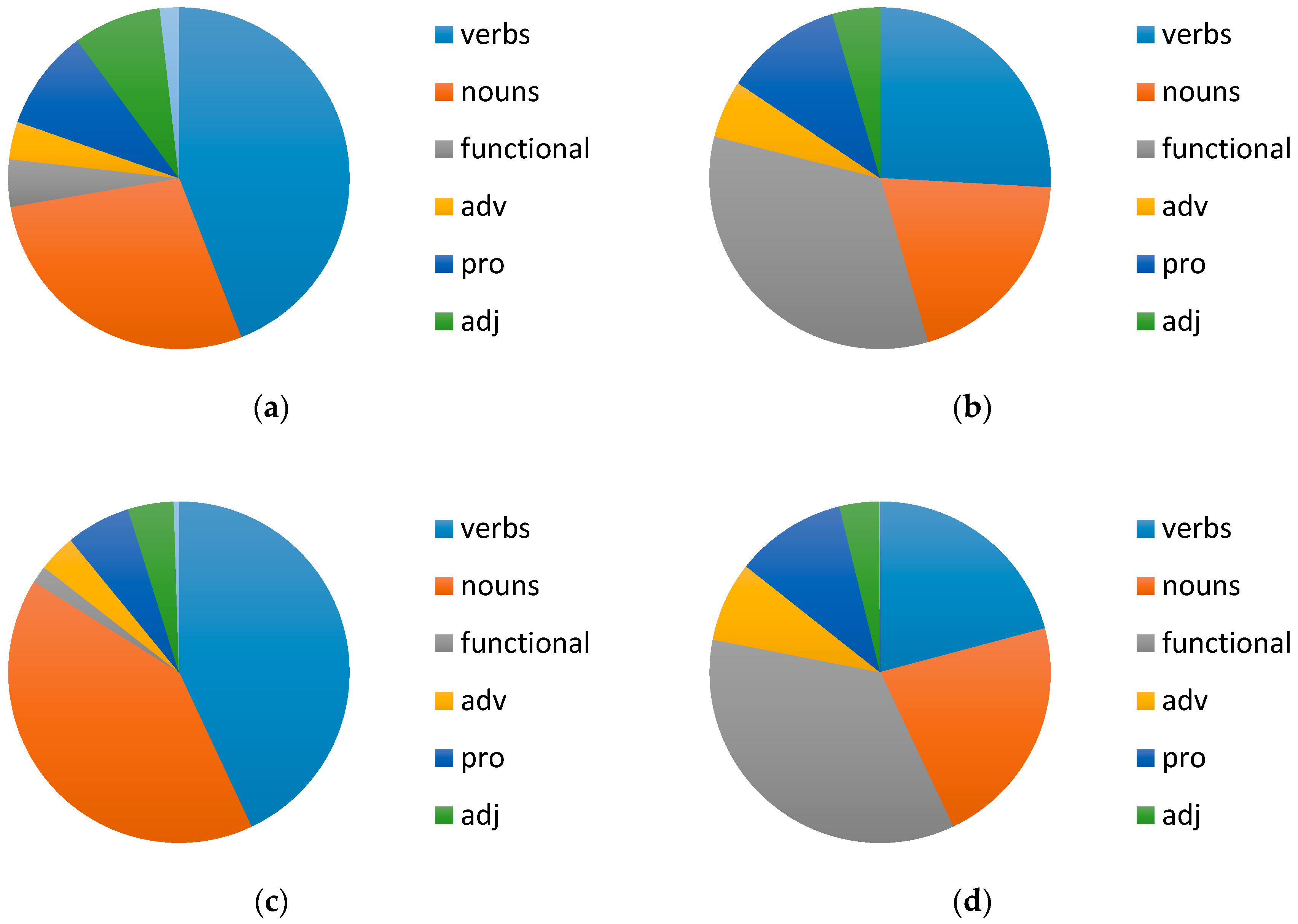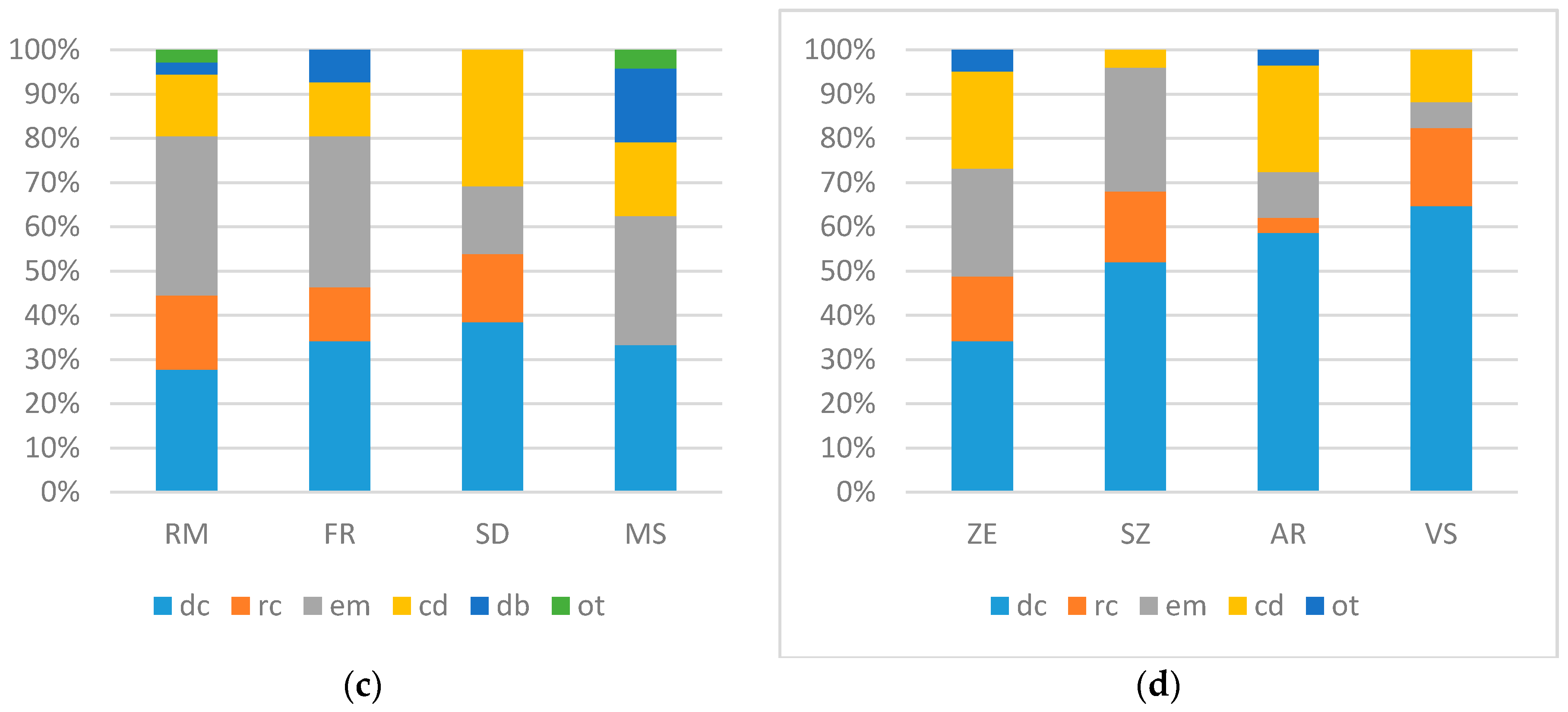Brazilian Bimodal Bilinguals as Heritage Signers
Abstract
:1. Introduction
Heritage language: The Case of Hearing Children of Deaf Parents
2. Materials and Methods
- mean length of utterance;
- word-per-minute rate;
- distribution of word types used;
- types of syntactic constructions used;
- verbal morphology production accuracy.
2.1. Participants3
2.2. Procedure
3. Results
4. Discussion
4.1. Empirical Discussion
| 1. | *DS(pato?-passou-na-frente-do-caminhão) |
| duck?-pass-in-front-of-truck | |
| ‘The duck went in front of the truck like so.’ |
| 2. | HOMEM SUSTO+ | PATO | DS(pato-passar-frente-caminhão) | DS(pato-caminhar) |
| man be-afraid | duck | duck-cross-in-front-of-the-truck | duck-walking | |
| ‘The man was frightened by the duck who was crossing in front of the truck like this.’ | ||||
4.2. General Discussion
4.2.1. What Determines the Range of Variation within the Heritage Speaker Cohort that We Are Considering? What is the Role of Language Use in a Given Context?
4.2.2. What Areas Are Vulnerable in Both Languages and What Areas Are Robust? Why?
5. Conclusions
Author Contributions
Funding
Acknowledgments
Conflicts of Interest
References
- Albirini, Abdulkafi, Elabbas Benmamoun, and Eman Saadah. 2011. Grammatical features of Egyptian and Palestinian Arabic heritage speakers’ oral production. Studies in Second Language Acquisition 33: 273–303. [Google Scholar] [CrossRef]
- Albirini, Abdulkafi, Elabbas Benmamoun, and Chakrani Brahim. 2013. Gender and number agreement in the oral production of Arabic Heritage speakers. Bilingualism: Language and Cognition 16: 1–18. [Google Scholar] [CrossRef]
- Bellugi, Ursula, Diane Lillo-Martin, Lucinda O’Grady, and Karen van Hoeck. 1990. The Development of Spatialized Syntatic Mechanisms in American Sign Language. In The Fourth International Sympsium on Sign Language Research. Edited by William H. Edmondson and Fred Karlson. Hamburg: Signum Verlag Press, pp. 16–25. [Google Scholar]
- Benmamoun, Elabbas, Silvina Montrul, and Maria Polinsky. 2013. Heritage languages and their speakers: Opportunities and challenges for linguistics. Theoretical Linguistics 39: 129–81. [Google Scholar] [CrossRef] [Green Version]
- Chomsky, Noam. 1986. Knowledge of Language: Its Origin, Nature and Use. New York: Praeger. [Google Scholar]
- Compton, Sarah E. 2014. American Sign Language as a Heritage Language. In Handbook of Heritage, Community, and Native American Languages in the United States: Research, Policy, and Educational Practice. Edited by Terrence G. Wiley, Joy Kreeft Peyton, Donna Christian, Sarah Catherine K. Moore and Na Liu. New York: Routledge, New York: Center for Applied Linguistics. [Google Scholar]
- Crasborn, Onno, and Han Sloetjes. 2008. Enhanced ELAN functionality for sign language corpora. In Construction and Exploitation of Sign Language Corpora. 3rd Workshop on the Representation and Processing of Sign Languages. Edited by O. Crasborn, E. Efthimiou, T. Hanke, E. Thoutenhoofd and I. Zwitserlood. Parijs: ELDA, pp. 39–43. [Google Scholar]
- De Quadros, Ronice Müller. 1995. As Categorias Vazias Pronominais. Master dissertation, Pontifícia Universidade Católica do Rio Grande do Sul, Porto Alegre, Brazil. [Google Scholar]
- De Quadros, Ronice Müller. 2017. Língua de herança: Língua brasileira de sinais. Porto Alegre: Penso Editora. [Google Scholar]
- De Quadros, Ronice Müller, Diane Lillo-Martin, and Karen Emmorey. 2016a. As línguas de bilíngues bimodais. Revista de Estudos Linguísticos da Univerdade do Porto 11: 139–60. [Google Scholar]
- De Quadros, Ronice Müller, Diane Lillo-Martin, and Deborah Chen Pichler. 2016b. Bimodal Bilingualism: Sign Language and Spoken Language. In The Oxford Handbook of Deaf Studies in Language. Edited by Marc Marschark and Patricia Elisabeth Spencer. Oxford: Oxford University Press, pp. 181–96. [Google Scholar]
- Döpke, Susanne. 1992. One Parent—One Language: An Interactional Approach. Amsterdam: John Benjamins Publishing Company. [Google Scholar]
- Emmorey, Karen. 2003. Perspectives on Classifier Constructions in Sign Languages. Mahwah: Lawrence Erlbaum Associates. [Google Scholar]
- Emmorey, Karen, Helsa B. Borinstein, Robin Thompson, and Tamar H. Gollan. 2008. Bimodal bilingualism. Bilingualism: Language and Cognition 11: 43–61. [Google Scholar] [CrossRef] [PubMed]
- Fishman, Joshua. 2001. 300-plus years of heritage language education in the United States. In Heritage Languages in America: Preserving a National Resource. Edited by Joy Kreeft Peyton, Donald A. Ranard and Scott McGinnis. Washington, DC and McHenry: Center for Applied Linguistics and Delta Systems, pp. 81–89. [Google Scholar]
- Johnston, Trevor. 1991. Transcription and glossing of sign language texts: examples from AUSLAN (Australian Sign Language). International Journal of Sign Linguistics 2: 3–28. [Google Scholar]
- Kanto, Laura, Kerttu Huttunen, and Marja-Leena Laakso. 2013. Relationship between the linguistic environments and early bilingual language development of hearing children in deaf-parented families. Journal of Deaf Studies and Deaf Education 18: 242–60. [Google Scholar] [CrossRef] [PubMed]
- Karnopp, Lodenir Becker. 1994. Aquisição do Parâmetro Configuração de Mão dos Sinais da LIBRAS: estudo sobre quatro crianças surdas filhas de pais surdos. Ph.D. dissertation, Instituto de Letras e Artes, Pontifícia Universidade Católica do Rio Grande do Sul, Porto Alegre, Brazil. [Google Scholar]
- Kondo-Brown, Kimi, ed. 2006. Heritage Language Development: Focus on East Asian Immigrants. Amsterdam: John Benjamins. [Google Scholar]
- Lanza, Elisabeth. 1997. Language Mixing in Infant Bilingualism. New York: Oxford University Press. [Google Scholar]
- Lillo-Martin, Diane, Ronice Müller de Quadros, Elena Koulidobrova, and Deborah Chen Pichler. 2010. Bimodal bilingual cross-language influence in unexpected domains. In Language Acquisition and Development: Proceedings of GALA 2009. Edited by João Costa, Ana Castro, Maria Lobo and Fernanda Pratas. Newcastle upon Tyne: Cambridge Scholars Press, pp. 264–75. [Google Scholar]
- Lillo-Martin, Diane, Ronice Müller de Quadros, Deborah Chen Pichler, and Zoe Fieldsteel. 2014. Language choice in bimodal bilingual development. Frontiers in Psychology 5: 1163. [Google Scholar] [CrossRef] [PubMed]
- Lillo-Martin, Diane, Ronice Müller de Quadros, and Deborah Chen Pichler. 2016. The development of bimodal bilingualism: Implications for linguistic theory. Linguistic Approaches to Bilingualism 6: 719–55. [Google Scholar] [CrossRef] [PubMed]
- Montrul, Silvina. 2011. Morphological errors in Spanish second language learners and heritage speakers. Studies in Second Language Acquisition 33: 163–92. [Google Scholar] [CrossRef]
- Palmer, Jeffrey Levi. 2015. ASL Word Order Development in Bimodal Bilingual Children: Early Syntax of Hearing and Cochlear-Implanted Deaf Children From Signing Families. Ph.D. dissertation, Gallaudet University, Washington, DC, USA. [Google Scholar]
- Petroj, Vanessa, Katelyn Guerrera, and Kathryn Davidson. 2014. ASL Dominant Code Blending in the Whispering of Bimodal Bilingual Children. In BUCLD 38: Proceedings of the 38th annual Boston University Conference on Language Development. Edited by Will Orman and Matthew James Valleau. Somerville: Cascadilla Press, vol. 2, pp. 319–30. [Google Scholar]
- Peyton, Joy Kreeft, Donald A. Ranard, and Scott McGinnis, eds. 2001. Heritage Languages in America: Preserving a National Resource. Washington, DC and McHenry: Center for Applied Linguistics and Delta Systems. [Google Scholar]
- Pichler, Deborah C., Julie Hochgesang, Diane Lillo-Martin, and Ronice Müller de Quadros. 2010. Conventions for sign and speech transcription in child bimodal bilingual corpora in ELAN. Language, Interaction and Acquisition 1: 11–40. [Google Scholar] [CrossRef]
- Pichler, Deborah C., James Lee, and Diane Lillo-Martin. 2014. Language development in ASL-English bimodal bilinguals. In Multilingual Aspects of Signed Language Communication and Disorder. Edited by David Quinto-Pozos. Bristol: Multilingual Matters, pp. 235–60. [Google Scholar]
- Pichler, Deborah C., Wanette Reynolds, Jeffrey Levi Palmer, Ronice Müller de Quadros, Viola Laura Kozak, and Diane Lillo-Martin. 2017. Heritage signers: Bimodal bilingual children from deaf families. In Language Acquisition at the Interfaces: Proceedings of GALA 2015. Edited by Jiyoung Choi, Hamida Demirdache, Oana Lungu and Laurence Voeltzel. Newcastle upon Tyne: Cambridge Scholars Publishing, pp. 247–69. [Google Scholar]
- Pizer, Ginger Bianca. 2008. Sign and Speech in Family Interaction: Language Choices of Deaf Parents and their Hearing Children. Ph.D. dissertation, The University of Texas at Austin, Austin, TX, USA. [Google Scholar]
- Polinsky, Maria. 2005. Word class distinctions in an incomplete grammar. In Perspectives on Language and Language Development. Edited by Maria Polinsky, Dorit Ravid and Hava Bat-Zeev Shyldkrot. Dordrecht: Kluwer Academic Press, pp. 419–36. [Google Scholar]
- Polinsky, Maria. 2006. Incomplete acquisition: American Russian. Journal of Slavic Linguistics 14: 191–262. [Google Scholar]
- Polinsky, Maria. 2008. Gender under Incomplete Acquisition: Heritage Speakers’ Knowledge of Noun Categorization. Heritage Language Journal 6: 40–71. [Google Scholar]
- Pyers, Jennie E., and Karen Emmorey. 2008. The face of bimodal bilingualism: Grammatical markers in American Sign Language are produced when bilinguals speak to English monolinguals. Psychological Science 19: 531–35. [Google Scholar] [CrossRef] [PubMed]
- Reynolds, Wanette. 2016. Early Bimodal Bilingual Development of ASL Narrative Referent Cohesion: Using a Heritage Language Framework. Ph.D. dissertation, Gallaudet University, Washington, DC, USA. [Google Scholar]
- Scontras, Gregory, Zuzanna Fuchs, and Maria Polinsky. 2015. Heritage language and linguistic theory. Frontiers in Psychology 6: 1545. [Google Scholar] [CrossRef] [PubMed]
- van den Bogaerde, Beppie, and Anne E. Baker. 2009. Bimodal language acquisition in Kodas. In Hearing, Mother-Father Deaf: Hearing People in Deaf Families. Edited by Michele Bishop and Sherry L. Hicks. Washington, DC: Gallaudet University Press, pp. 99–131. [Google Scholar]
| 1 | We use a capital D for Deaf to indicate the linguistic-cultural group rather than a medical diagnosis. |
| 2 | We call the spoken language the second language because of chronology, even though the spoken language ends up being the dominant language (or the other language if they are balanced bilinguals). |
| 3 | Research approval was granted by the Review Board at the Universidade Federal de Santa Catarina. IRB: CAAE 0014.0.242.000-09. |



| Group | Participant | Interpreter? | Sign Rating * | Speech Rating * |
|---|---|---|---|---|
| Bimodal bilinguals | CL | yes | 7 | 7 |
| MR | no | 6 | 7 | |
| JB | no | 4 | 7 | |
| NT | no | 3 | 6 | |
| Deaf signers | RM | no | 7 | n/a |
| FR | no | 7 | n/a | |
| SD | no | 7 | n/a | |
| MS | no | 7 | n/a | |
| Hearing non-signers | ZE | no | n/a | 7 |
| SZ | no | n/a | 7 | |
| AR | no | n/a | 7 | |
| VS | no | n/a | 7 |
| Group | Participant | Sign Words/Minute | Speech Words/Minute | Ratio Speech:Sign | Sign MLUw | Speech MLUw | %Sign VMorph Errors |
|---|---|---|---|---|---|---|---|
| Bimodal bilinguals | CL | 73.84 | 74.29 | 1.01 | 5.50 | 7.46 | 0 |
| MR | 86.25 | 155.60 | 1.81 | 3.63 | 6.40 | 3 | |
| JB | 63.42 | 126.00 | 1.99 | 3.70 | 6.47 | 12 | |
| NT | 48.15 | 41.66 | 0.87 | 2.54 | 5.00 | 59 | |
| Deaf signers | RM | 129.12 | n/a | n/a | 7.27 | n/a | n/a |
| FR | 79.81 | n/a | n/a | 6,68 | n/a | n/a | |
| SD | 77.85 | n/a | n/a | 6,04 | n/a | n/a | |
| MS | 100.71 | n/a | n/a | 5,64 | n/a | n/a | |
| Hearing non-signers | ZE | n/a | 102.47 | n/a | n/a | 9.88 | n/a |
| SZ | n/a | 107.14 | n/a | n/a | 9.00 | n/a | |
| AR | n/a | 147.64 | n/a | n/a | 8.96 | n/a | |
| VS | n/a | 143.63 | n/a | n/a | 6.37 | n/a |
© 2018 by the authors. Licensee MDPI, Basel, Switzerland. This article is an open access article distributed under the terms and conditions of the Creative Commons Attribution (CC BY) license (http://creativecommons.org/licenses/by/4.0/).
Share and Cite
Quadros, R.M.d.; Lillo-Martin, D. Brazilian Bimodal Bilinguals as Heritage Signers. Languages 2018, 3, 32. https://doi.org/10.3390/languages3030032
Quadros RMd, Lillo-Martin D. Brazilian Bimodal Bilinguals as Heritage Signers. Languages. 2018; 3(3):32. https://doi.org/10.3390/languages3030032
Chicago/Turabian StyleQuadros, Ronice Müller de, and Diane Lillo-Martin. 2018. "Brazilian Bimodal Bilinguals as Heritage Signers" Languages 3, no. 3: 32. https://doi.org/10.3390/languages3030032
APA StyleQuadros, R. M. d., & Lillo-Martin, D. (2018). Brazilian Bimodal Bilinguals as Heritage Signers. Languages, 3(3), 32. https://doi.org/10.3390/languages3030032





